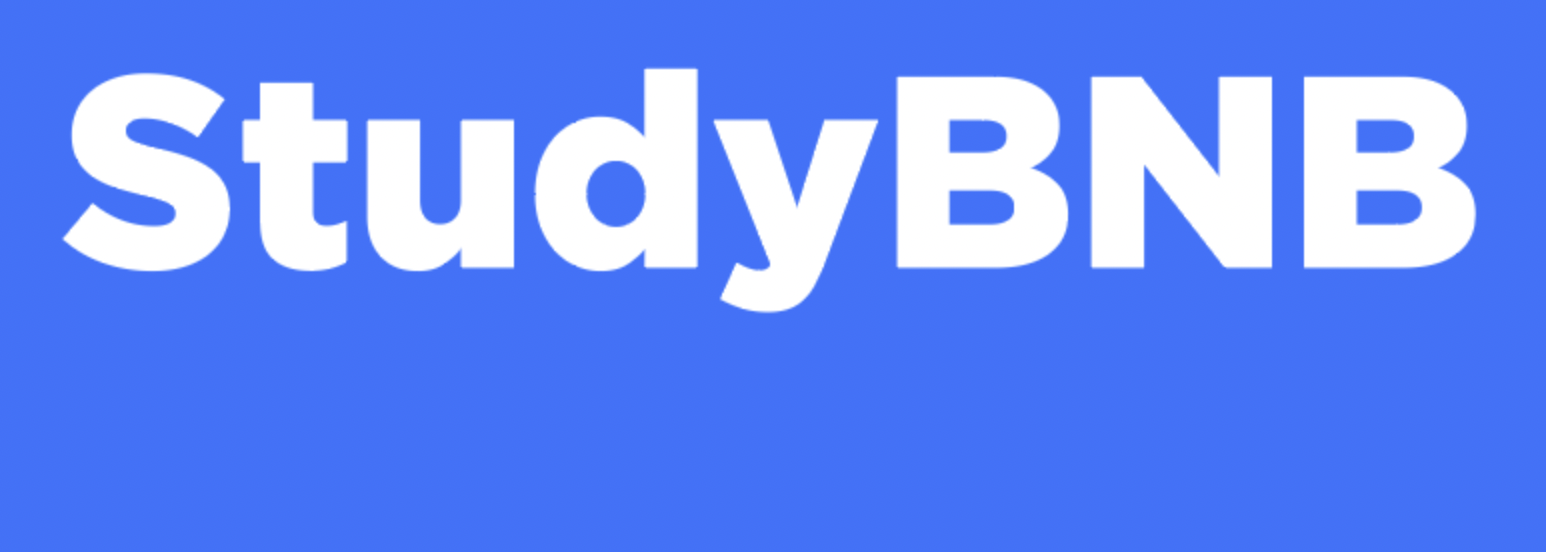StudyBNB
HYU AI/SE project 21-2 : Friend-like software that helps us study efficiently, 'StudyBNB'
Members
- Kim Useong, jeneve1@hanyang.ac.kr
- Park Hankyu, official03x@hanyang.ac.kr
- Chi Sangyun, csy9604@hanyang.ac.kr
- Michael Sklors, skmi1013@h-ka.de
Links
- Notion page: https://ancient-fighter-d30.notion.site/StudyBNB-c63a5795d9de42758a436764d5bca04d
- Demo Video: https://www.youtube.com/watch?v=EPOi7vhCWR0
- Documentation: https://github.com/Five-Guys-NUGU/documentation
Proposal
Studying and reading is always present in our daily life, especially as a college student. When we study, it is easy to lose track of the hours spent and forgetting to take breaks. This results in being inefficient for the goal of studying for a class or an exam. Conversely, it is easy to lose concentration due to the temptation to use laptops and cell phones. From these cases, we thought that it would be good to students to provide a time-check application for studying. By using our application, students can see whether they should have rest at proper time, and they can focus on their study more. The ultimate question to answer is always "How can I be more efficient with my time for studying?"
Problematic Situation
- Can't check own study time exactly
- Memorization that relies only on sight
Solution
- Study Time Checker
- Memorizing notes using speakers
Related software and research
Yeolpumta(열품타)
Forest
Focus To-DO: Pomodoro Timer
QandA
AI TOEIC - RIIID Tutor
Development Environment
Application
- Tool: Android Studio
- Language: Kotlin
- API: Google Vision API
Server
- Tool: Visual Studio Code
- Language: Python
- Database: Firebase(Firestore)
- Cloud Server: AWS EC2
- Backend: Flask
AI Model
- Tool: Visual Studio Code
- Language: Python
- API: Scikit-learn
Overall Architecture

The figure displays that StudyBNB consists of three parts: Frontend, Backend and external Cloud. The frontend focuses on the visual elements of the app that the user interacts with while the backend focuses on the server side that the user can't see. The external cloud provides interaction with external services.
Frontend is represented by the mobile app and the NUGU speaker. The former one allows interaction with the modules "login", "timer", "notes" and "settings". The "login" function makes use of Google sign-in and communicates with the Google API. NUGU Speaker needs to work with the NUGU API to use functions of the mobile app.
Backend is represented by the cloud consisting of the backend capabilities of Firebase and its Firestore database. The functions from the frontend save and retrieve data in Firebase. Another part of the backend is the app server which is built on the Python web-framework Flask. The app server has an timer function that uses words from the NUGU speaker and data from Firebase as input and starts the timer. For machine learning capabilities, data from the Firestore database is used to train the model for image recognition and matching users capabilities. Inside the app server the model will be applied for the notes function.
Datasets
StudyMate
StudyBNB provides StudyMate matching functionality using data such as 'average learning time per day, average number of breaks per day' for users in Firebase DB.
However, data about the number of learning hours and breaks of these users were generally not readily available. Therefore, we created virtual dummy data and used it to check the accuracy of the matching function. In fact, there will be a variety of subjects of interest for users during commercialization, but since we have created dummy data for functional testing, we decided to unify all users' subjects into "TOEIC" and analyze only one subject of TOEIC.

Note-taking
StudyBNB provides Optical character recognition (OCR) function that converts images uploaded by users into text.
All Latin-based text can be recognized using ML Kit's text recognition API provided by Google Firebase. Text recognition can automate cumbersome text input, and users can edit extracted text. These data are uploaded to Cloud Firestore whenever the user uses the Note-taking function to check the accuracy of the ML Kit.

Methodology
StudyMate
-
Why is it K-mean Clustering?
We used 'K-mean clustering' as a matching algorithm. We wanted to make two of the most similar users among those learning the same subject into one matching group. Since there was no label that indicates user information, we decided to divide users into several clusters using clustering among machine learning techniques and randomly select and match two users in each cluster.
One of the clustering techniques, the K-mean clustering technique, does not need to set the number of clusters in advance and searches for similar clusters based on Euclidean distance, so we thought it was suitable for the purpose of matching two highly similar objects.
-
Data Normalization
There is a big difference between using raw data as it is for clustering and proceeding with clustering after data normalization. If raw data is used as it is, the influence of features with a larger scale can be too large than those of features that do not. We decided to go through a normalization process to prevent such a phenomenon.
sdscaler = StandardScaler() df[['total_study_time', 'avg_study_time']] = sdscaler.fit_transform(df[['total_study_time', 'avg_study_time']]) -
Finding Best K
K-mean clustering works even if the number of clusters is not determined in advance, but if the range of K is not determined, there can be two problems. If K becomes too small a number, almost all users will belong to the same cluster, and there may be no reason to turn this matching algorithm around. Conversely, if K becomes too large a number, users may differentiate into very large clusters, and many users may not be matched. This is because if there are odd numbers of users in one cluster, one user will fail to match.
Therefore, we decided to determine the range of K and find the optimal K that can divide all users into the most distinctive clusters within that range. To ensure that K has a reasonable value, not too little or too large, we consider K with the highest Silhouette Score among natural numbers K satisfying the range of 2 <= K <=
round(root(N))as optimal K.def findBestK(df): sil = [] kmax = round(math.sqrt(len(df))) for k in range(2, kmax + 1): kmeans = KMeans(n_clusters = k).fit(df[['total_study_time', 'avg_study_time']]) labels = kmeans.labels_ sil.append(silhouette_score(df[['total_study_time', 'avg_study_time']], labels, metric = 'euclidean')) return (2 + sil.index(max(sil))) -
K-mean Clustering
K-mean clustering was conducted using the optimal K found.
def kmean(df, k): kmeans = KMeans(n_clusters = k).fit(df[['total_study_time', 'avg_study_time']]) labels = kmeans.labels_ return labels -
Matching inside each clusters
Two users were randomly selected and matched within each cluster of clustering results. If the cluster consists of an odd number of users, the last one user will fail to match.
def match(lists): couples = [] for list in lists: if len(list) % 2: list.pop() random.shuffle(list) for i in range(0, len(list), 2): temp_arr = [] temp_arr.append(df_uid[list[i]]) temp_arr.append(df_uid[list[i+1]]) couples.append(temp_arr) return couples
Note-taking
- OCR in Android Application The implementation method of OCR within the app is as follows. To recognize the text in the image, create an object called
Bitmap,media.image,ByteBuffer, andFirebase VisionImagefrom a byte array or device file. TheFirebase VisionImageobject is then forwarded to theprocessImagemethod ofFirebase VisionTextRecognizer, and when the task is performed, the image is converted into text.
if(requestCode == 0 && resultCode == Activity.RESULT_OK && data != null){
selectedPhotoUri = data.data
val bitmap = MediaStore.Images.Media.getBitmap(contentResolver, selectedPhotoUri)
if(bitmap != null){
img_btn.setImageBitmap(bitmap)
}else{
val icon = BitmapFactory.decodeResource(getResources(), R.drawable.photo_default)
img_btn.setImageBitmap(icon)
}
// Create a FirebaseVisionImage object from your image/bitmap.
val firebaseVisionImage = FirebaseVisionImage.fromBitmap(bitmap!!)
val firebaseVision = FirebaseVision.getInstance()
val firebaseVisionTextRecognizer = firebaseVision.onDeviceTextRecognizer
// Process the Image
val task = firebaseVisionTextRecognizer.processImage(firebaseVisionImage)
task.addOnSuccessListener { firebaseVisionText: FirebaseVisionText ->
//Set recognized text from image in our TextView
val text = firebaseVisionText.text
contents_view!!.setText(text)
}
}Evaluation & Analysis
StudyMate
- Before / After Normalization Before normalization, the scale of 'total_study_time' is very large compared to 'avg_study_time', whereas after normalization, the two features show the same scale.
Before Normalization After Normalization 

- Silhouette Score Silhouette Score, which determines the best K, shows that it is better to set it to K=4 for the case.

- K-mean Clustering Result This graph visualizes the results of K-mean clustering. Each cluster is expressed in a different color.

Note-taking
- Data recognition accuracy was checked by comparing/analyzing the similarity between the text in the image and the text converted into the image.
- As a result of analyzing the accuracy of data recognition by collecting about 30 pieces of data, it showed about 98.6% accuracy.
Use cases
Android application
- Login/Main pages
| Login page | Main page | Setting page |
|---|---|---|
 |  |  |
- Timer
| Measuring time | Attempt to change screen | Today's cumulative learning time. |
|---|---|---|
 |  |  |
- Note-taking
| List of subjects | List of notes | One of the lists |
|---|---|---|
 |  |  |
NUGU AI Speaker
Installation
If the user purchases the NUGU Speaker, completes the speaker setup, and installs the NUGU application on the user's smartphone, the user is ready to use StudyBNB. If you press the menu in the upper left corner on the main screen of the NUGU application on your smartphone, StudyBNB exists in the Education/Childcare tab of the NUGU Play category.
Starting Application:
- Command: "Aria, start StudyBNB"
Start Timer
- Command: "Aria, Start timer for SUBJECT(including Korean History Exam, TOEIC, Computer Specialist in Spreadsheet & Database(CS)) from BNB"
Finish Timer
- Command: "Aria, Finish timer from BNB"
Calculate study time for now
- Command: "Tell me what time I studied from BNB"
Calculate study time by subject or date
- Command: "Tell me how long I studied the TOEIC yesterday from BNB"
Read Studynote
- Command: "Read wrong answer note of SUBJECT(like TOEIC, Korean History, CS) from BNB"
Get studymate's information
- Command: "Tell me how much my studymate studyied from BNB"
User guide
Installation
- Android Application
Our application will be released in the Play Store. Users will be able to download our aplication in Play Store. You can find our application with keywords such as 'studybnb', 'study timer', 'note-taking', 'studymate'.
- NUGU AI Speaker
If the user purchases the NUGU Speaker, completes the speaker setup, and installs the NUGU application on the user's smartphone, the user is ready to use StudyBNB. If you press the menu in the upper left corner on the main screen of the NUGU application on your smartphone, StudyBNB exists in the Education/Childcare tab of the NUGU Play category.
Conclusion
When we first started our development plan, we planned to provide two paths: smartphone apps and AI speakers with two AI-based services: StudyMate and Note-taking.
However, due to limited development capabilities and time constraints, we had no choice but to produce slightly modified results from the initial plan. Among the many parts, the most regrettable thing is that the StudyMate function was not fully implemented in the app. If the service can be expanded as planned, I think we can make it more functionally completed software.

